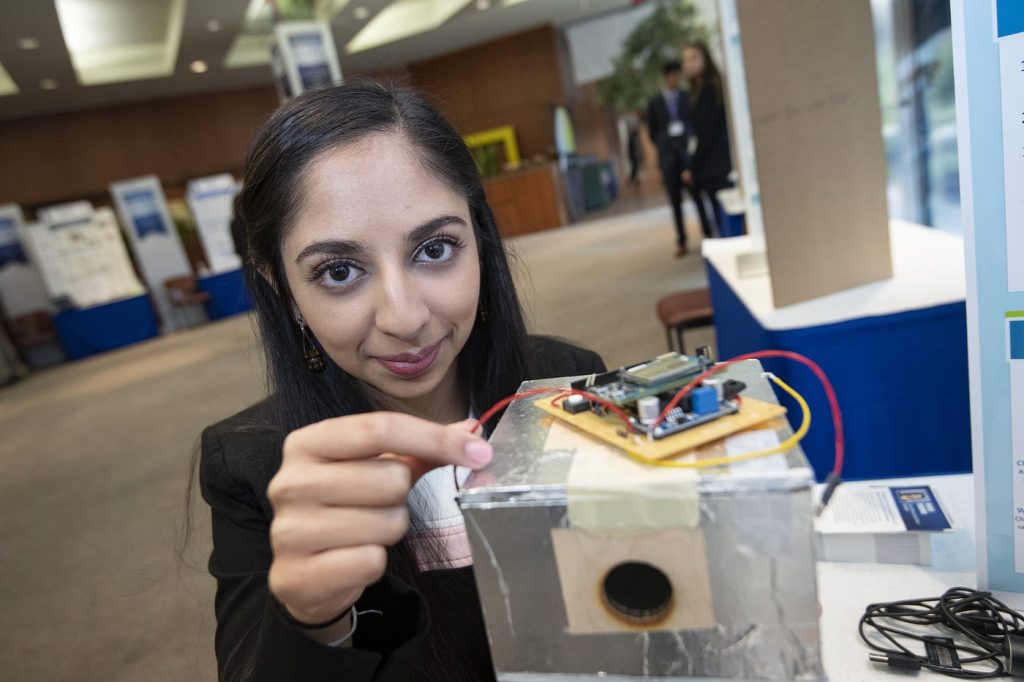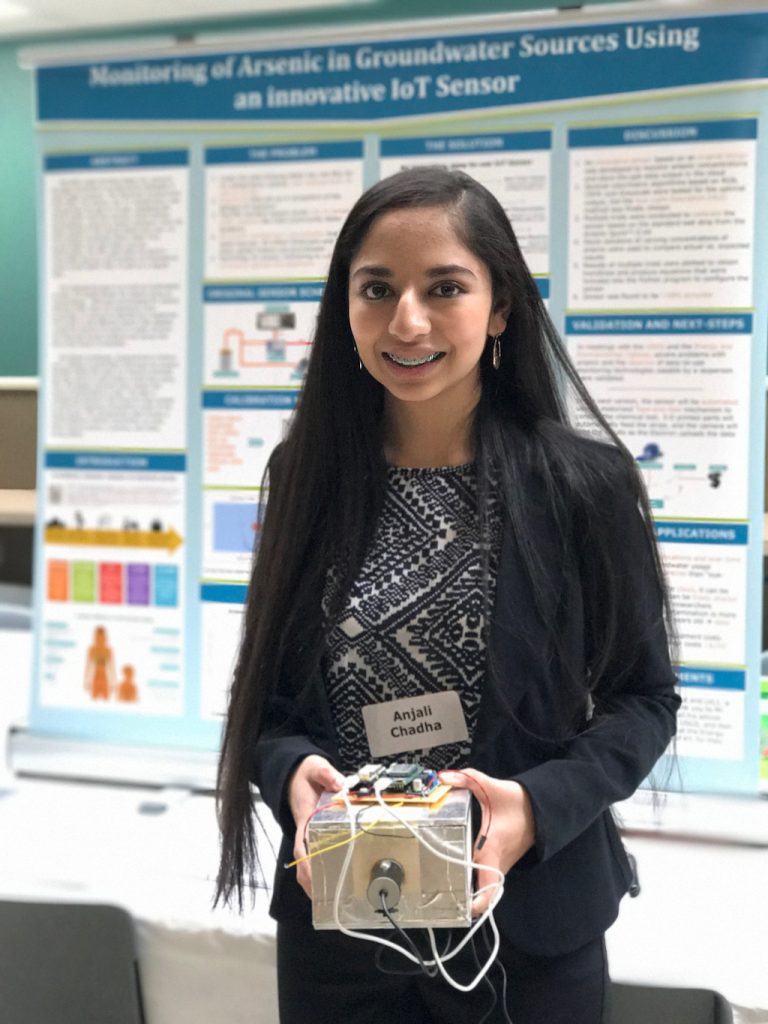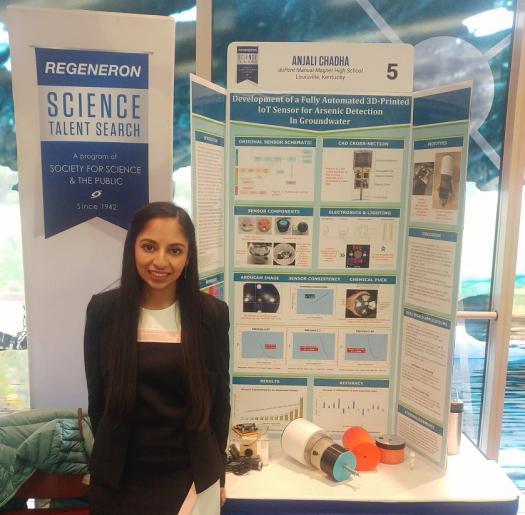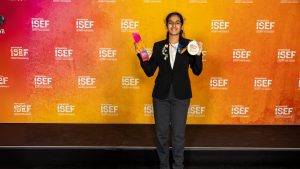(May 16, 2025) In parts of the world—even in the United States—people still drink water that can poison them. That’s not an exaggeration. It’s the reality for millions who rely on wells contaminated with arsenic, a toxic chemical that causes cancer and other serious health problems. Anjali Chadha was just a teenager when she found out that several counties in her home state of Kentucky had dangerously high levels of arsenic in their groundwater. What shocked her more? Most people didn’t even know their water was unsafe.
“I couldn’t believe this was happening so close to home,” she said in an interview. That moment changed everything for Anjali. Determined to find a solution, she started building a simple, affordable sensor that could detect arsenic in water and send the results to the cloud in real-time.
The project took over a year to build—but it worked. And in 2019, her invention earned her national recognition as a finalist in the Regeneron Science Talent Search, one of the most prestigious science competitions for high school students in the United States. At just 17, Anjali stood among the top 40 teen scientists in the country—not for a lab experiment, but for creating a device that could save lives.

A Love for Science from the Start
Anjali’s interest in science began early. Growing up in Louisville, Kentucky, she was the kind of kid who preferred books about the solar system and the human body over fairy tales. “Some of the first real books I read were scientific,” she shared. “I liked learning things that helped me understand how the world works.”
With both parents in technology and a mother who worked in STEM, Anjali had plenty of support at home. “My family encouraged me to ask questions and solve problems,” she said. Her grandparents, too, inspired her. They often spoke about the importance of education, especially for girls.
But it wasn’t until middle school that Anjali saw just how unequal opportunities in science could be. Her school had a special math and science magnet program, but half the students came from the nearby neighborhood. “The difference between the two groups was huge,” she said. “A lot of girls, especially from minority backgrounds, felt intimidated by STEM. They didn’t think it was for them.”
That stuck with Anjali—and later became part of her mission.
Creating the Arsenic Sensor
After learning about the arsenic crisis in Kentucky, Anjali started researching. She discovered the problem was even bigger than she thought. In the U.S., around 50 million people use private wells, which aren’t regularly tested for arsenic. Globally, countries like India and Bangladesh face major health risks because of arsenic-contaminated groundwater.
She wondered: why wasn’t there an easy way for people to test their water?


So, she set out to build one. Her goal was to create a low-cost, easy-to-use device that didn’t need lab equipment. The result was a small sensor that used a chemical reaction to turn arsenic into a gas. This gas would change the color of a test strip, and a built-in computer would measure the color and calculate the arsenic level. The results could be uploaded instantly to the cloud.
The best part? It cost around $350 to make—and one sensor could be used by a whole village.
Her invention caught the attention of the Regeneron Science Talent Search, and in 2019, Anjali became one of just 40 students selected from across the country. She won a $25,000 prize and got the chance to present her project in Washington, D.C. “Being from Kentucky, a state that deals with coal mining and environmental issues, I wanted to find a solution that actually helps people,” she told Society for Science.
Bridging the STEM Gap with Empowered
While building her sensor, Anjali was also thinking about something else: how to bring more girls like her into science and tech. In 2016, she founded a nonprofit called Empowered, Inc. Its mission? Teach minority high school girls technology skills—and then connect them with small, women-owned businesses that need digital support.
At first, Empowered was just Anjali helping local entrepreneurs build websites and manage social media. But soon, she started training girls to take on those projects themselves. Each summer, Empowered hosts a seven-week program where students learn web design, marketing, and coding. After that, they’re paired with real businesses to put their new skills to work.
“Confidence and passion can take you a long way,” Anjali said in an interview. “You don’t have to wait to be older or more experienced to make a difference.”
Through Empowered, she’s helped dozens of girls get hands-on experience—and shown them that STEM isn’t just for a select few.


Proudly Indian, Proudly Global
Anjali’s journey is deeply connected to her identity as an Indian-American. She’s grown up balancing two cultures and using that blend to guide her goals. She studied Bharatanatyam, a classical Indian dance form, for over 10 years. Her family’s background in India—where access to clean water wasn’t always guaranteed—also played a big role in shaping her outlook.
“My family in India now has clean water, but my grandparents didn’t always have that,” she said. “It made me realize how lucky I am—and how much work there’s still to do.”
Her arsenic sensor wasn’t just for the U.S. It was designed with global communities in mind—places where testing water is still a luxury. Her invention shows how one person can help people both at home and across the world.
Anjali has also become a role model. She was named a “Voice of the Year” by Seventeen magazine, and became an ambassador for the AAAS IF/THEN initiative, which highlights women in STEM. A life-size 3D-printed statue of her was even displayed in a museum to inspire other girls to pursue science.
The Journey Ahead
Anjali, who now works in the UK, studied biological engineering at MIT. But she hasn’t slowed down. She’s still working on solving real-world problems, still mentoring young girls, and still reminding others that anyone—no matter their age or background—can make a difference.
“STEM is so vast—there’s certainly a place for you in it,” she says.
For teens living abroad, Anjali’s story is a powerful example. She’s proof that you can take your skills, your culture, and your voice—and turn them into real change. You don’t need to wait to be older. You just need to care enough to start.
Because sometimes, the biggest impact begins with a simple question: How can I help?
- Follow Anjali Chadha on LinkedIn
ALSO READ | Shanya Gill on TIME’s Kid of the Year Honoree List: It’s an honour




